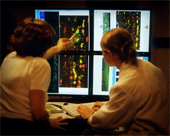You are here:
Laboratory of Stem Cell Biology
Mahendra Rao, M.D., Ph.D.
Chief, Laboratory of Stem Cell Biology
Phone: 301-594-6667
E-mail: mraomah@mail.nih.gov
Research Interests
The goal of the Laboratory of Stem Cell Biology is to use stem cells to improve our understanding of the biological processes controlling of cell fate determination and tissue development. To accomplish this goal, the lab will use various types of stem cells to generate neurological disease models, in drug discovery, and for the development of replacement therapies for neurodegenerative diseases and disorders. The hope is that versatile stem cells may someday be a source of replacement cells for damaged tissues of the brain and other organs.
One specific target for possible treatment with cellular therapies is Parkinson's disease, which causes the death of nerve cells in the brain that are needed for agile and controlled muscle movement. Symptoms of the disabling malady include hand tremors and an inability to walk. Dr. Rao, in collaboration with researchers at his previous position, developed methods to induce stem cells to transform into the type of nerve cells that are depleted in Parkinson's disease. These nerve cells produce dopamine, a chemical signal that helps deliver the brain's orders to the muscles. Their team was been able to derive such nerve cells from embryonic stem cells, and also from the modified adult cells, called induced pluripotent stem cells. These induced pluripotent stem cells can mimic the versatility of embryonic stem cells.
A second target for treatment is peripheral neuropathy, and, in particular, neuropathies caused by defects in Schwann cells. The Rao laboratory has developed method to take iPSC and ESC cells and differentiate them towards the neural crest lineage, which then gives rise to cells of the peripheral nervous system, including Schwann cells. Their laboratory has developed methods to obtain a pure population of Schwann cells and is working with collaborators to develop an in vitro myelination model to screen for small molecules that may aid functional recovery.

A) Human dermal fibroblasts. B) iPSC colony derived from human dermal fibroblasts. C) Embryoid Body formation, merged image of Beta III Tubulin staining of neurons and DAPI staining of non-neuronal cells.
Selected Publications
Macarthur CC, Xue H, Van Hoof D, Lieu PT, Dudas M, Fontes A, Swistowski A, Touboul T, Seerke R, Laurent LC, Loring JF, German MS, Zeng X, Rao MS, Lakshmipathy U, Chesnut JD, Liu Y. Chromatin Insulator Elements Block Transgene Silencing in Engineered Human Embryonic Stem Cell Lines at a Defined Chromosome 13 Locus. Stem Cells Dev. 2011
![]()
Hester ME, Murtha MJ, Song S, Rao M, Miranda CJ, Meyer K, Tian J, Boulting G, Schaffer DV, Zhu MX, Pfaff SL, Gage FH, Kaspar BK. Rapid and Efficient Generation of Functional Motor Neurons From Human Pluripotent Stem Cells Using Gene Delivered Transcription Factor Codes. Mol Ther. 2011 Jul 19. doi: 10.1038/mt.2011.135.
![]()
Vemuri MC, Chase LG, Rao MS. Mesenchymal stem cell assays and applications. Methods Mol Biol. 2011;698:3-8.
![]()
Liu Y, Rao M. Gene targeting in human pluripotent stem cells. Methods Mol Biol. 2011;767:355-67.
![]()
Swistowski A, Peng J, Liu Q, Mali P, Rao MS, Cheng L, Zeng X. Efficient generation of functional dopaminergic neurons from human induced pluripotent stem cells under defined conditions. Stem Cells. 2010 Oct;28(10):1893-904.
![]()
Chase LG, Lakshmipathy U, Solchaga LA, Rao MS, Vemuri MC. A novel serum-free medium for the expansion of human mesenchymal stem cells. Stem Cell Res Ther. 2010 Apr 2;1(1):8.
![]()
Swistowska AM, da Cruz AB, Han Y, Swistowski A, Liu Y, Shin S, Zhan M, Rao MS, Zeng X. Stage-specific role for shh in dopaminergic differentiation of human embryonic stem cells induced by stromal cells. Stem Cells Dev. 2010 Jan;19(1):71-82.
![]()
Kuegler PB, Zimmer B, Waldmann T, Baudis B, Ilmjärv S, Hescheler J, Gaughwin P, Brundin P, Mundy W, Bal-Price AK, Schrattenholz A, Krause KH, van Thriel C, Rao MS, Kadereit S, Leist M. Markers of murine embryonic and neural stem cells, neurons and astrocytes: reference points for developmental neurotoxicity testing. ALTEX. 2010;27(1):17-42.
![]()
Han Y, Miller A, Mangada J, Liu Y, Swistowski A, Zhan M, Rao MS, Zeng X. Identification by automated screening of a small molecule that selectively eliminates neural stem cells derived from hESCs but not dopamine neurons. PLoS One. 2009 Sep 23;4(9):e7155.
![]()
Loulier K, Lathia JD, Marthiens V, Relucio J, Mughal MR, Tang SC, Coksaygan T, Hall PE, Chigurupati S, Patton B, Colognato H, Rao MS, Mattson MP, Haydar TF, Ffrench-Constant C. beta1 integrin maintains integrity of the embryonic neocortical stem cell niche. PLoS Biol. 2009 Aug;7(8):e1000176.
![]()
Reviewed December 10, 2012




